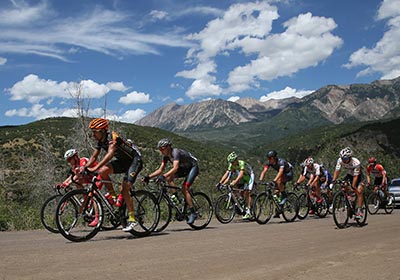
Riders Climb Into Thin Air at the USA Pro Challenge
Have you ever taken a friend from sea level hiking in the Rockies, only to find her gasping for air, or feeling lightheaded, after just a few uphill steps? Colorado's altitude poses a major hurdle for all visitors, including the elite cyclists who will participate in next month's USA Pro Cycling Challenge
Have you ever taken a friend from sea level hiking in the Rockies, only to find her gasping for air, or feeling lightheaded, after just a few uphill steps?
Colorado's altitude poses a major hurdle for all visitors, including the elite cyclists who will participate in next month's USA Pro Challenge. When riders from Europe's biggest professional teams pedal into the mountains, they experience the same shortness of breath and lightheaded sensation as your friend.

But in a bike race, you can't stop and catch your breath.
Some riders say it feels like breathing through a straw. Others say that the altitude just makes them feel tired. Alex Howes of the Cannondale-Garmin pro cycling team, says the thin air just makes everyone hurt.
"You see a lot of guys come in from Holland or France, and they go backwards on the climbs," says Howes, who grew up in Colorado. "You need to know how to meter out your efforts at altitude."
Colorado's peaks are an oddity in pro cycling, where the major races are predominantly held at lower elevations. The highest point of this year's Tour de France, the Col du Tourmalet, tops out at 6,939 feet. Italy's Passo dello Stelvio climb, which is regarded as one of the toughest in the world, stands at just 9,048 feet.
By contrast, the top of Independence Pass, which the riders climb during Stage 3 of this year's USA Pro Cycling Challenge, is 12,095 feet. The race has nine categorized climbs above 9,000 feet.
What does this mean? Our bodies require oxygen to power our muscles. But at higher altitudes, the oxygen content is significantly reduced. According to the medical website Altitude.org, at 12,000 feet, the air contains 65% as much oxygen as it does at sea level.
This 35% difference may appear minor, but it has an enormous impact on both the riders and the dynamics of the race. On climbs, cyclists attempt to distance themselves from each other by stomping on the pedals and accelerating forward. At lower altitudes, a cyclist can put in multiple surges all the way to the top. He must simply recover from each effort for a few seconds before launching a new attack.

But at high altitude, a rider cannot recover from these surges as quickly. If he surges too many times, he may lose his ability to pedal forward entirely. Riders call this "popping." So instead of attacking multiple times, a cyclist must ride conservatively and save his efforts for crucial moments.
"If you have 10 bullets in your gun at sea level, you only have 5 at altitude," says Travis McCabe of the SmartStop Pro Cycling Team. "So instead of attacking, the group just gets smaller the higher up you get.
As you watch the action live or on TV, be sure to watch the riders as they tackle the climbs. You're more than likely to see riders drop off the back, one by one, leaving the strongest athletes to battle for the win.
Below are the high points of this year's race that are guaranteed to test the riders' legs and lungs.
Stage 2 (Steamboat Springs to Arapahoe Basin)
- RabbitEars Pass (9,391')
- Ute Pass (9,570')
- Arapahoe Basin (10,780')
Stage 3 (Copper Mountain to Aspen)
- Fremont Pass (11,079')
- Independence Pass (12,095')
Stage 4 (Aspen to Breckenridge)
- Independence Pass (12,095')
- Hoosier Pass (11,542')
- Moonstone Road (10,088')
Stage 5 (Breckenridge Time Trial)
- Moonstone Road (10,088')
Stage 6 (Loveland to Fort Collins)
- Rist Canyon (8,008')
About the author:
Fred Dreier is a journalist living in Denver, Colorado.
He has written about professional bicycle racing since 2004, and his work has appeared in a wide variety of magazines and newspapers, such as The New York Times, The Wall Street Journal and USA Today. Dreier has covered the USA Pro Cycling Challenge since its debut in 2011. He regularly rides his bicycle on many of the roads used by the race.












